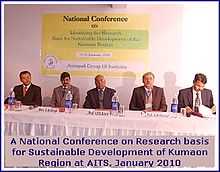Ashok Malhotra (professor)

Ashok Malhotra (born 1950, Pune, India) is an Indian Professor, higher education professional and author. He is the son of Colonel A. P. Malhotra and Nand Rani Malhotra (Nando). He is the brother of Lt. General Anoop Malhotra He graduated from the Indian Institute of Technology in 1971 with a degree in Mechanical Engineering. Dr. Ashok Malhotra received a doctoral degree in Mechanical Engineering from the University of British Columbia, Canada in 1978. He has been on the faculty of the Indian Institute of Technology, Delhi, The University of British Columbia Canada and the University of Mosul in Iraq. His most recent appointment during 2009–2010 was as the Director of the Amrapali Institute of Technology and Sciences in the Nainital District of India

.
Supercritical Fluids
Ashok Malhotra has had special interests in supercritical fluids. His Ph.D. Thesis was on supercritical carbon dioxide. He has also worked on the optimal design of power plants using supercritical steam and written a book on supercritical steam. Following is a quotation on it by Christopher Mims,
“Supercritical steam has already been used in coal-fired and nuclear power plants. The mechanism by which it yields higher efficiency is complicated, but ultimately it boils down to this: steam turbines need very hot steam in order to produce power, and supercritical steam is much closer to this temperature than cooler steam, says Ashok Malhotra, who literally wrote the book on the subject (Thermodynamic Properties of Supercritical Steam)” Christopher Mims
Turbulent Prandtl Number
The Turbulent Prandtl number is a non-dimensional parameter required in convective turbulent heat transfer calculations. The simplest model for turbulent Prandtl Number is the Reynolds analogy, which yields a turbulent Prandtl number of unity however based on. From experimental data based on air or water adjustments have been made to values slightly different from unity. Its counterpart the Prandtl number is employed in laminar flow calculations. However, most flows in nature are turbulent rather than laminar and therefore incorporating the use of turbulent Prandtl Number becomes necessary. Its use can be entirely bypassed through more complicated and advanced heat flux modelling but challenges still remain in its formulation. Ashok Malhotra and Kang (1984)[1] showed through calculations in a circular pipe that the Turbulent Prandtl Number is not close to unity but rather a strong function of the moleculer Prandtl number amongst other parameters . They developed relationships between the turbulent and moleculer Prandtl number that can be employed in convective heat transfer calculations. Their work has been substantiated by other researchers e.g.. McEligot and Taylor, 1996[2] and Churchill[3]
Publications
Recent publications by Ashok Malhotra include, How to Create excellent Universities[4] and Steam Property Tables[5] Some publications from his research areas of solar energy, heat transfer and fluid flow are, Minimizing convective heat losses in flat plate solar collectors,[6] Modelling the flow in a Hydrocyclone,[7] Optimal Geometries of Solar concentrators.,[8] heat exchangers[9] and thermodynamic properties of steam[10]
Other Activities
Aside from his professional interests in higher education, science and technology, Ashok Malhotra's interest range from the environment to the economy; from ancient history to philosophy. He regularly shares his views on such topics with the wider online community through his blogs. He has also authored a novel and a novella that elaborate his environmental and philosophical views through the medium of fiction.
References
- ↑ Malhotra, A. and Kang, S. S., Turbulent Prandtl number in circular pipes, 1984, vol. 27, no11, pp. 2158–2161,International Journal of Heat and Mass Transfer ISSN 0017-9310
- ↑ McEligot, D. M. & Taylor, M. F. 1996, The turbulent Prandtl number in the near-wall region for Low-Prandtl-number gas mixtures. Int. J. Heat Mass Transfer., 39, pp 1287—1295
- ↑ Churchill, S. W. 2002; A Reinterpretation of the Turbulent Prandtl Number. Ind. Eng. Chem. Res., 41, 6393–6401. CLAPP, R. M. 1961
- ↑ Malhotra, A., How to Create Excellent Universities, 2012. ISBN 978-1479108565
- ↑ Malhotra, A., Steam Property Tables ISBN 978-1479230266
- ↑ Malhotra A.; Garg H. P.; Rani U, Minimizing convective heat losses in flat plate solar collectors, Solar Energy, vol. 25, no. 6, 1980, p. 521-526.
- ↑ Malhotra A, Branion R M R, Hauptmann E G, Modelling the flow in a Hydrocyclone, 1994,The Canadian Journal of Chemical Engineering, Vol. 72 pp 953–960
- ↑ Mullick S C, Malhotra A, Nanda S K, Optimal geometries of composite plane mirror cusped linear solar concentrator with flat absorber, 1988, Solar Energy, Vol 40, Issue 5, Pages 443- 456
- ↑ A. R. Siddiqui, A. Malhotra & O. P. Chawla, 1984, Optimization Of A Heat Exchanger Chain Consisting of Two Cold Streams, Volume 7, Issue 2, Engineering Optimization, pp 157–166
- ↑ Malhotra,A. and Panda, D. M. R., 2001,Thermodynamic properties of superheated and supercritical steam, Volume 68, Issue 4, Applied Energy, pp 387–393
External links
- An analytical investigation of forced convective heat transfer to supercritical carbon dioxide flowing in a circular duct
- One Hot Island: Iceland's Renewable Geothermal Power by Christopher Mims
- Ions Profile of Ashok Malhotra
- Profile by Ashok Malhotra